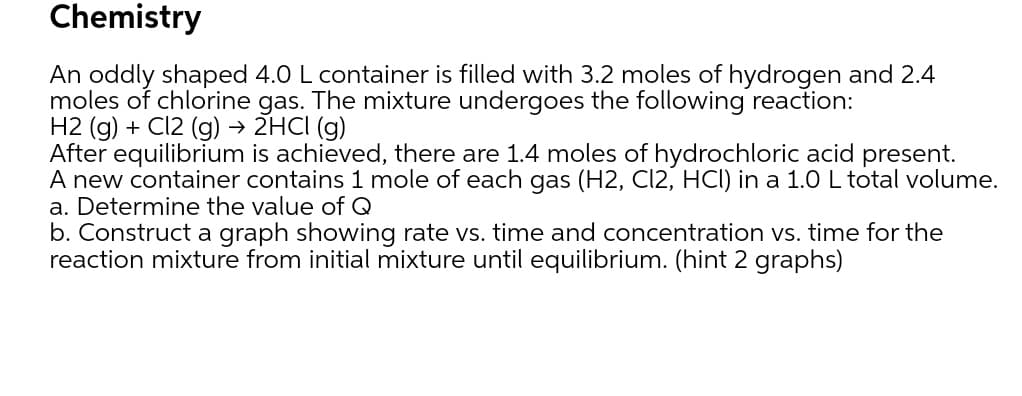An oddly shaped 4.0 L container is filled with 3.2 moles of hydrogen and 2.4 moles of chlorine gas. The mixture undergoes the following reaction: H2 (g) + Cl2 (g) → 2HCI (g) After equilibrium is achieved, there are 1.4 moles of hydrochloric acid present. A new container contains 1 mole of each gas (H2, Cl2, HCI) in a 1.0 L total volume. a. Determine the value of Q b. Construct a graph showing rate vs. time and concentration vs. time for the reaction mixture from initial mixture until equilibrium. (hint 2 graphs)
An oddly shaped 4.0 L container is filled with 3.2 moles of hydrogen and 2.4 moles of chlorine gas. The mixture undergoes the following reaction: H2 (g) + Cl2 (g) → 2HCI (g) After equilibrium is achieved, there are 1.4 moles of hydrochloric acid present. A new container contains 1 mole of each gas (H2, Cl2, HCI) in a 1.0 L total volume. a. Determine the value of Q b. Construct a graph showing rate vs. time and concentration vs. time for the reaction mixture from initial mixture until equilibrium. (hint 2 graphs)
Chemistry & Chemical Reactivity
10th Edition
ISBN:9781337399074
Author:John C. Kotz, Paul M. Treichel, John Townsend, David Treichel
Publisher:John C. Kotz, Paul M. Treichel, John Townsend, David Treichel
Chapter15: Principles Of Chemical Reactivity: Equilibria
Section: Chapter Questions
Problem 43GQ: Phosphorus pentachloride decomposes at elevated temperatures. PCl5(g) PCl3(g) + Cl2(g) An...
Related questions
Question
Please give all questions answers with explanation

Transcribed Image Text:Chemistry
An oddly shaped 4.0 L container is filled with 3.2 moles of hydrogen and 2.4
moles of chlorine gas. The mixture undergoes the following reaction:
H2 (g) + Cl2 (g) → 2HCI (g)
After equilibrium is achieved, there are 1.4 moles of hydrochloric acid present.
A new container contains 1 mole of each gas (H2, Cl2, HCI) in a 1.0 L total volume.
a. Determine the value of Q
b. Construct a graph showing rate vs. time and concentration vs. time for the
reaction mixture from initial mixture until equilibrium. (hint 2 graphs)
Expert Solution
This question has been solved!
Explore an expertly crafted, step-by-step solution for a thorough understanding of key concepts.
Step by step
Solved in 4 steps with 4 images

Knowledge Booster
Learn more about
Need a deep-dive on the concept behind this application? Look no further. Learn more about this topic, chemistry and related others by exploring similar questions and additional content below.Recommended textbooks for you

Chemistry & Chemical Reactivity
Chemistry
ISBN:
9781337399074
Author:
John C. Kotz, Paul M. Treichel, John Townsend, David Treichel
Publisher:
Cengage Learning

Chemistry & Chemical Reactivity
Chemistry
ISBN:
9781133949640
Author:
John C. Kotz, Paul M. Treichel, John Townsend, David Treichel
Publisher:
Cengage Learning

Chemistry
Chemistry
ISBN:
9781305957404
Author:
Steven S. Zumdahl, Susan A. Zumdahl, Donald J. DeCoste
Publisher:
Cengage Learning

Chemistry & Chemical Reactivity
Chemistry
ISBN:
9781337399074
Author:
John C. Kotz, Paul M. Treichel, John Townsend, David Treichel
Publisher:
Cengage Learning

Chemistry & Chemical Reactivity
Chemistry
ISBN:
9781133949640
Author:
John C. Kotz, Paul M. Treichel, John Townsend, David Treichel
Publisher:
Cengage Learning

Chemistry
Chemistry
ISBN:
9781305957404
Author:
Steven S. Zumdahl, Susan A. Zumdahl, Donald J. DeCoste
Publisher:
Cengage Learning


Chemistry: An Atoms First Approach
Chemistry
ISBN:
9781305079243
Author:
Steven S. Zumdahl, Susan A. Zumdahl
Publisher:
Cengage Learning

Chemistry: The Molecular Science
Chemistry
ISBN:
9781285199047
Author:
John W. Moore, Conrad L. Stanitski
Publisher:
Cengage Learning